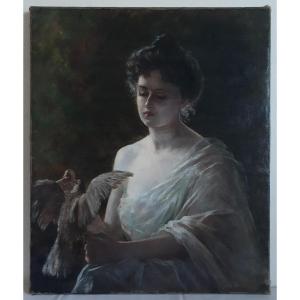The artist enlarged the right side of the panel by one centimeter.
Dimensions without frame: 35 cm x 26.5 cm, with frame 60 cm x 53 cm.
Henry Mosler (1841-1920) was born in Eastern Europe and arrived in New York with his parents at the age of 8. Two years later, the family moved to Cincinnati, where it was a large German Jewish community. Henry, while still a teenager, apprenticed to a wood engraver, Horace C. Grosvenor, and also learned the basics of painting from an amateur landscape painter, George Kerr. From 1859 to 1861, he studied with James Henry Beard and from 1862 to 1863, during the American Civil War, he served as a war correspondent for Harper's Weekly. In 1863, Henry Mosler went to Düsseldorf, where he studied at the Royal Academy for nearly three years, receiving instruction from Heinrich Mücke and Albert Kindler. He then went to Paris, where he studied for six months with Ernest Hébert. He returned to Cincinnati in 1866, where he received numerous portrait commissions. After marrying Sara Cahn in Cincinnati in 1869, Henry Mosler returned to France in 1874, then studied in Munich for three years under Carl Theodor Von Piloty, winning a medal at the Royal Academy. In 1877, he returned to France, where he passed through Pont-Aven. He received a silver medal at the Paris Salon in 1889, and a gold medal in Paris in 1888 and in Vienna in 1893. He remained in France until 1894. Henry Mosler traveled through the Pont-Aven region between 1879 and 1884, where he painted rural scenes with sometimes heightened realism. Mosler was part of the artistic movement of the late 19th century that praised rural life. In 1894, he moved with his family to New York. He became an associate of the American Academy of Design and continued to paint during the early years of the 20th century. He died of a heart attack at the age of 78. His works are exhibited in numerous American museums.



































 Le Magazine de PROANTIC
Le Magazine de PROANTIC TRÉSORS Magazine
TRÉSORS Magazine Rivista Artiquariato
Rivista Artiquariato